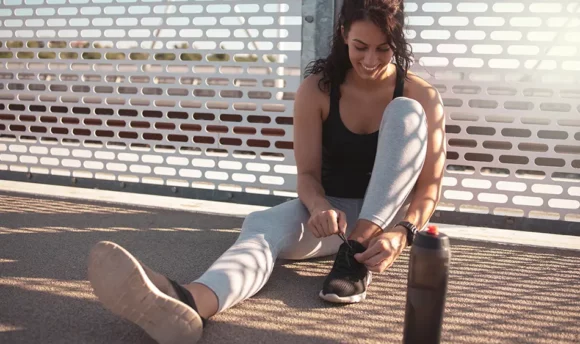How to Start Running at 40? Benefits, Tips, and Running Program
Here are some tips you need to know to start a running program in your 40s.

The prospect of running intimidates many people, especially adults aged 40 and older. But you have nothing to be scared of because running is not only for people in their 20s. In fact, adults above 30–40 often perform like they are at their running peak.
Today, we’ve compiled the best tips and tricks you need to be a mature runner. Scroll down and read more!
Is It Not Too Late to Start Running at 40?
Running is a great way to get fit, stay in shape and have fun. But even though it demands a lot of physical energy, anybody, regardless of age, can do it. So, it’s not too late for you to start running at 40.
However, if you were leading a sedentary life before, ease into running with a brisk walk. Every five minutes, break your walk by jogging for two minutes. Then, walk again until you complete 10 minutes of jogging.
Afterward, increase each run by one minute until you’re able to jog for 30 minutes without stopping. The brisk walk trick works to boost your endurance and muscular fitness.
Also, remember that having a consistent running routine at 40 isn’t just for fun. It helps you lose weight, improves your cardiovascular health, and strengthens your bones and muscles.
Likewise, it improves flexibility by increasing blood flow throughout the body. With that, your skin cells repair themselves faster after injury or illness.
It also lowers risk factors associated with type 2 diabetes – including body fat percentage, blood sugar levels, and insulin resistance.
5 Benefits of Running in Your 40s
Let’s now discuss the benefits of running mentioned above.
You will feel more energized
When you run and develop a fitness routine, your body releases hormones called endorphins and endocannabinoids. Due to endocannabinoids, after a long run, runners tend to feel ‘runner’s high.’
Running and other forms of exercise help to increase energy levels. According to Harvard, a consistent fitness routine like running converts more blood glucose into fuel inside the cell mitochondria.
For a very long time now, scientists have been calling mitochondria “the powerhouses of a cell.” So, the more you exercise, the more energized you become.
It will improve your sleep quality
When you run, your body releases hormones called endorphins and serotonin. These hormones help with muscle relaxation and stress relief. Also, it is important to note that serotonin promotes and regulates our sleep cycles.
Helps with weight loss
Running can be not only a fun activity but also a useful one. It is one of the best cardio activities, which doesn’t require a huge budget and promotes fat burning.
According to Harvard Medical School, a 125 lb person burns 240 kcal after running at 5mph for 30 minutes. If you weigh 155 lb or 185 lb, you burn 288 and 336 kcal, respectively, for covering the same distance at a similar pace.
So, the more you run, the less likely you are to become obese, the more you burn calories, and the longer you live on earth.
Decreases risks of cardiovascular diseases
Cardiovascular diseases are those that affect the cardiovascular system, which includes the heart and blood vessels. They include heart disease, stroke, high blood pressure, diabetes, and cancer.
The American Heart Association states that people who run regularly have a lower risk of developing these conditions than those who don’t exercise at all.
It will be easier to break bad habits
Bad habits like binge eating, heavy drinking, and smoking are quite hard to break. When you have them, you often feel like they hit all your pleasure points. So, keep craving that good feeling.
This feeling comes from a brain chemical called dopamine. Dopamine is like a reward neurochemical that floods your brain each time you do something pleasurable.
Whether the action that produces the dopamine is bad or good, you will always long for more. And that’s why it’s very difficult to kick against bad habits. For someone at 40, the difficulty doubles because you’ve likely been addicted to these habits longer.
So, you will feel a lot of emotional blues as you try to give up a bad habit. These emotional discomforts are called “withdrawal symptoms.” Signs of withdrawal can include anxiety, headache, insomnia, vomiting, and hand tremors.
So, yes, it’s a lot of pain to bear. However, according to the research from the Department of Psychology at the University of the West of England, regular power-packed exercise can help you cope with such discomforts. Luckily for you, running is one of those exercises that work just great.
Besides that, regular running and other exercise routines also stimulate the brain to produce dopamine. The same that is produced when you drink, smoke, and do other peccadilloes you love. So, with regular running, it won’t take long for your brain to appreciate the healthier alternative.
Finally, research from the American Physiological Society states that regular exercise suppresses the hunger hormone called ghrelin. So, the more you exercise, the less you feel cravings. And the lesser the cravings, the dampened the pain.
How to Start Running in Your 40s
Yes, running is not something meant only for those from their early 20s to late 30s. But that doesn’t mean anybody in their 40s can just wake up one day, gear up, and run a mile.
As a 40-year-old, your bones are aging, and this limits how much you can tolerate the rigors of physical exercises, like running. So, it’s best you see your doctor first about your intentions to run.
Let the doctor examine you physically and mental-wise. Once you have a green light from your healthcare provider, you can then hop straight onto the following running tips:
Start with comfortable clothes
As mature runners, you need to realize that your run-of-the-mill clothes and shoes won’t cut it. You need sleeker ones that will make you feel comfy and safe. For someone in their 40s, you need to pay closer attention to the safety part.
For safety, you need to add essential running gear like running shoes, moisture-wicking clothes, and socks to your list. Although, they don’t have to be fancy or expensive. They just have to meet a few exercise routine safety requirements to prevent injuries.
For instance, as a new runner, you need to look out for the treading and the nature of the shoe material to see if they fit your running path and time.
For example, in most cases, shiny shoes with thicker treads are good for early morning and late-evening road runners. That way, drivers can see them from afar.
Begin with walking
For someone in their 40s, running at the get-go might be very difficult. To help you blend into the process, you can simply start with walking.
For effectiveness, try walking a mile in about 20 minutes. If that’s too harsh on your body, you can begin with something as little as 10 minutes a day. After a week, increase it to 15 minutes and keep adding 5 minutes every three days until you can walk for 30 minutes.
Continue with light jogging
Once you can walk as described above, you may feel you are ready for the big steps. That’s normal because almost all new runners look to ramp up their speed within days of starting.
However, at age 40 or older, you need to be more cautious about your strides, pace, and distance covered. All these affect your body, and if you jack things up too aggressively, it can take a bad toll on your health.
So, instead of hopping from walking to running, consider intermittent jogging to reduce injury. One way to add jogging into your walking routine is to jog for two minutes after every 10 minutes of walking.
Try running and different running strategies
Once you find the right pace and you can start running without stopping, there are some strategies to try out. They are not simply fun but also it skyrocketing your running results.
Out there, you will find many running strategies that can boost your strength, endurance, and speed. Here, let’s talk about some that are good for people in their 40s:
Tempo Runs
Tempo runs, aka threshold runs, are pacing exercises where you sustain a particular speed for about 20–30 minutes. That speed, also called the lactate threshold, is the speed at which muscles just feel fatigued because of the accumulation of a compound called lactic acid.
But to start tempo runs, you need to figure out the speed you can maintain for about 20–30 minutes. Warm up a little, and then run at your chosen speed for as long as you can. The more you practice this tempo run, the better your stamina. This will go a long way to help anyone in their 40s.
Form Runs
There’s a high chance that in your 40s, you no longer know how best to position your body to run fast. With form runs, you can learn about the postures you need to maintain while running.
Besides that, form runs also teach you the best posture to avoid injury. Again, safety should always be the priority for anyone looking to run in their 40s. Form runs can give you that.
Reverse Splits
In your 40s, fatigue will easily set in when you run. But when you do reverse splits, aka negative splits, you learn to always keep going.
To run negative splits, all you have to do is to break your total race into groups of 3, say every 15 minutes. Start out slowly, increase your pace at the midway point and return to a slower pace in the last third. The idea is to run the whole course in such cycles.
Don’t forget cross-training
At age 40 or older, you may need to take some time off running. At least, this would let your bones, joints, and muscles recover from the stress and pain associated with running. However, you still need to exercise.
So, sometimes, you may need to dilute your training routine with other less-strenuous activities like cycling, swimming, rowing, skipping ropes, and any other activity you feel like. For one, this will make your running schedule more fun. Also, you get to try out new things.
Running Program for People Over 40.
Besides running shoes and willpower, a running coach is another thing that can help your race life at 40 or older. However, running coaches in the US charge $50–$100 per session. But not everyone can afford them. So, most people often settle for running programs and apps.
Today, one of the best running apps out there for people over 40 is the Joggo app. Here are a few things you need to know about it:
Key Features
- Joggo has a personalized plan that works for all ages, weights, and lifestyles.
- It has a treadmill mode and educational tricks that can augment your pace.
- It features different stretching and cool-down exercises.
- It makes you feel rewarded for commitment.
A Word From Our Coach
Running is an affordable sport that anyone in their 40s can do. Besides that, running comes with a full package of benefits for anyone that’s willing to take the bold step. Over time, you get better. But certain things can mess up your routine. So, here are two golden rules you should always remember:
1. Your race life is not a competition.
So, avoid comparing yourself with others, especially those that are younger. At first, you may enjoy the spirit of comparing and competing. But those that are younger are likely to run faster and outperform you.
When that happens, you, as a more mature runner, may lose the motivation to continue running. But when you remember that your competition is your mirror, you’ll learn to cut out unhealthy competitions.
2. Join a running club for your peer group.
It’s pretty easy to give up when you’re alone. To increase your chances to keep running, join local clubs. There, you may find a running buddy that’ll stay with you for life.
Conclusion
In this article, we discussed how running at 40 or older helps to break bad habits, launch strength training, aid weight loss, and improve sleep. But you shouldn’t just start running suddenly.
Instead, you need to get a medical clearance from your doctor. With a green light, get yourself the right running kit, and start with walk-jog intervals and a slow jog. Be sure to take walking breaks when you need them.
Once your body copes well with that, you can hop to the core exercises and start trying out different running strategies. To do this, you might need a running coach or a running program. If you prefer an app that can guide you all the way through, Joggo is a brilliant choice.

















































 Select your language:
Select your language: 








